-
United States -
United Kingdom -
India -
France -
Deutschland -
Italia -
日本 -
대한민국 -
中国 -
台灣
-
Ansys is committed to setting today's students up for success, by providing free simulation engineering software to students.
-
Ansys is committed to setting today's students up for success, by providing free simulation engineering software to students.
-
Ansys is committed to setting today's students up for success, by providing free simulation engineering software to students.
-
Contact Us -
Careers -
Students and Academic -
For United States and Canada
+1 844.462.6797
ANSYS BLOG
March 26, 2024
Simulation Enables SiC Module Designs at STMicroelectronics
See how Ansys is supporting ST's success in electric vehicle application development to drive new energy and industrial solutions.
Power electronics are on a rapid development trajectory punctuated by spurts of innovation, from the personal devices we carry to the electric vehicles (EVs) we drive, and the data centers supporting them all. It seems that as soon as one device is released, a new version of that device stretches our expectations even further.
Power electronics, also known as high-power electronics, differ from general electronics as they involve the management of high voltages and currents, of which semiconductors are a primary example. Within microchips, these high-performance power transistors efficiently conduct massive currents to enable high-performance computing and meet other workload demands across a wide range of technologies — all within the confines of just a few millimeters.
One semiconductor that’s getting the attention of the power electronics industry is silicon carbide (SiC). It’s a semiconductor and silicon alternative known for its high electrical conductivity, and low thermal expansion enabling high-temperature applications. This makes SiC well-suited to a variety of power applications including:
- EV charging systems (inverters)
- Energy handling (generation, conversion, distribution storage)
- Industrial machines (mass market robotics in manufacturing plants)
- Power supply in data centers
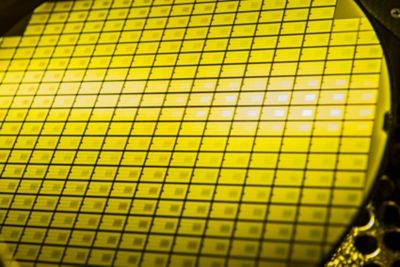
Silicon carbide wafer
Today, the rapid expansion of the EV and power electronics markets is driving significant demand for SiC-based components and systems. A steady stream of SiC components will be needed to power EVs sales through 2030, which are projected to reach 64 million, or four times the estimated volume sold in 2022. To this end, recent research suggests that SiC metal-oxide field effect transistors (MOSFETs) will be critical to the advancement of EV powertrains due to their high switching frequency, thermal resistance, and breakdown voltage.
This is good news for STMicroelectronics, a leader in semiconductor technology solutions. ST pioneered the first automotive-grade SiC MOSFETs and has supplied STPOWER™ SiC devices already powering more than 5 million passenger cars currently on the road. Ansys’ simulation technology supports ST in assessing all aspects impacting the performance, robustness, and reliability of the final EV applications. It is also supporting the success of ST’s third-generation Silicon Carbide MOSFETs in other markets by helping increase efficiency, performance, and reliability in industrial power and sustainable energy applications.
“Ansys simulation enables us to build to expand beyond our automotive presence,” says Gaetano Bazzano, R&D CAD and Modeling Manager at STMicroelectronics. “SiC module technology is crucial for delivering the power electronics needed in sustainable energy solutions like solar inverters and energy storage. It’s equally important in industrial power-control applications involving motor drives, power supplies, and robotics.”
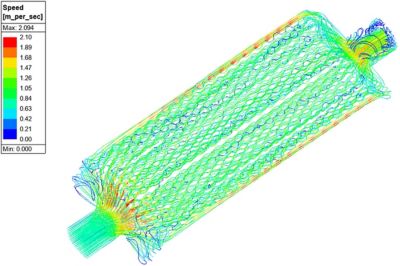
Fluid velocity stream lines
Simulation Turns Up the Heat
Power electronics performance of both components and systems is a function of the materials used in their design and fabrication — namely conductors, semiconductors, and insulators — as they deliver varying degrees of electrical conductivity. Of the three, the electrical conductivity of semiconductors is critical to the development of these components as they can be manipulated to suit a given application in terms of energy efficiency, signal integrity, thermal management, and reliability.
Today, power semiconductor SiC is playing an increasingly significant role in a variety of electronics applications including EVs, where reliability is of the utmost importance. This is because many of these applications must endure extremely high temperatures. Depending on their composition, as temperatures fluctuate, electronic components in each system are subject to various degrees of thermal expansion. These differences, or changes in shape between components may result in thermal stresses that lead to mechanical failures.
Running thermomechanical simulations in Ansys Icepak enables ST to quickly and accurately evaluate the behavior and integrity of its SiC power module design subject to these environmental conditions and identify potential premature failures. In this virtual environment, engineers can assess the distribution of heat within the device, then identify and address any critical points that could stress the system and lead to overheating or failure.
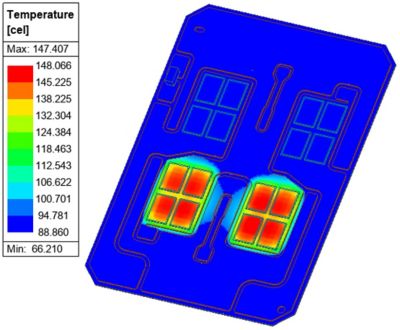
Power module thermal map, single switch temperature behavior
How to Make Cooling Compromises During Development
While minimizing power losses is important, heat generated by large current flow can cause power semiconductor module failures, especially in high-temperature environments. Therefore, efficient cooling mechanisms must be considered to maintain high power density for continuous output without compromising module performance, reliability, efficiency, and longevity.
Introducing cooling techniques into the mix can increase heat transfer rates, or the rate at which heat is directed away from a semiconductor device. Yet these same techniques may also increase pressure drop or the level of resistance to coolant flow in the system. This increase will in turn draw more energy from the system to push a cooling fluid (in this case, air or liquid) through the system to cool the component. Pressure drop can also lower the heat transfer rate, further impacting system efficiency.
Consequently, finding the best compromise between the rate of heat transfer and level of pressure drop is fundamental for achieving optimal thermal performance in various automotive applications.
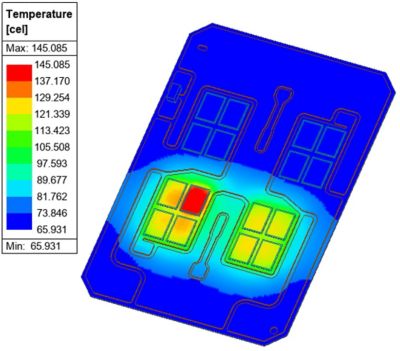
Power module thermal map, considering unbalanced die belonging to the same switch
Putting it all Together with Ansys Mechanical
ST engineers rely on mechanical simulations to assess structural integrity of the entire model module. Consideration is given to stresses, including vibrations, shocks, and deformations that can occur during operation. Zeroing in on a specific module design in Ansys Mechanical, engineers can optimize a given module design for peak operating performance to reduce the risk of failure and improve device reliability overall.
Running mechanical and thermo-mechanical simulations in Mechanical yields important insights regarding the behavior of a power module under real operating conditions to ensure proper heat dissipation and reliability. This level of analysis enables critical points of the power module to be identified and design modifications to be made to improve its robustness, while minimizing the number of (often costly) physical prototypes required during testing.
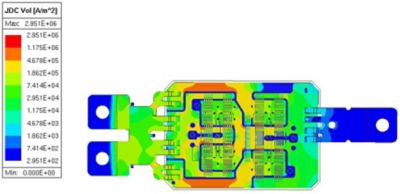
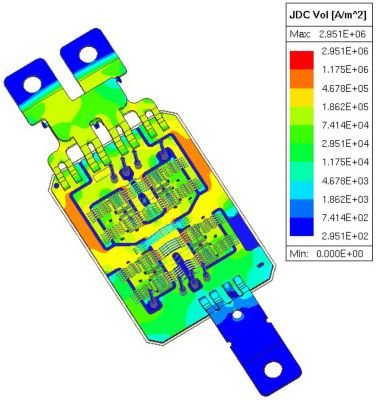
Current density map from dc+ to dc-
And all these physics are interdependent. Thermal, fluids, and mechanical effects must be analyzed together as they interact at various levels, from nanometer-scale transistor devices to millimeter- and centimeter-scale SiC modules like inverters. Ansys' true multiphysics, multi-scale simulation solution provides the proper environment for virtual validation of advanced Silicon Carbide modules.
“The efficacy of mechanical and thermomechanical simulations are equally important to us during power module analysis,” says Bazzano. “We address this analysis within Mechanical, a trusted solver for us that’s been important for understanding the structural integrity of our SiC MOSFET designs during development. As a result, we’ve been able to identify potential issues early on, and significantly reduce our prototyping and development activities. We can then streamline development times and internal engineering costs for our customers by the early identification of improvement points.”
Find out how Ansys empowers system-level design and optimization solutions for power electronic systems, including inverters, converters, sensors and semiconductors.











